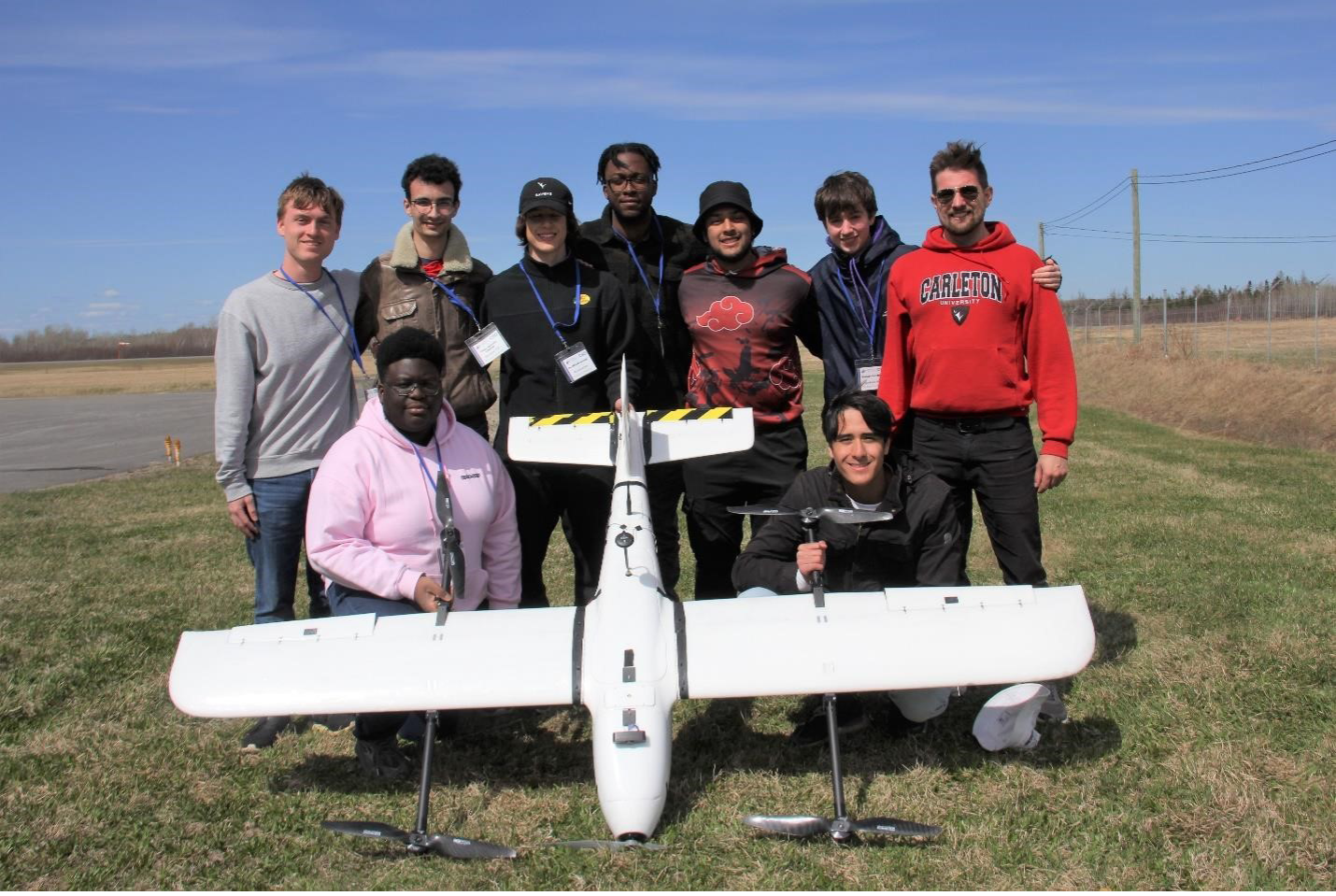GOOD NEWS: Blackbird UAV Team Wins at 14th Annual Aerial Evolution Association of Canada (AEAC) National Student Competition 2022-2023
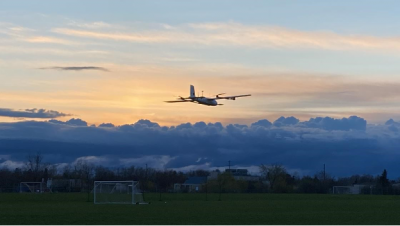
The Department of Mechanical and Aerospace Engineering is thrilled to announce the win for Carleton Blackbird UAV Team at the 14th Aerial Evolution Association of Canada (AEAC) Student UAS Competition 2022-2023. The Blackbird UAV Team won 1st place in Phase 2 – Flying Phase of the competition in Alma, Quebec earlier in May 2023. Phase 2 is the actual in-person flying demonstration portion of the competition. Carleton has previously never placed better than 3rd place in Phase 2, however, they have previously won Phase 1 – Design Paper Competition. Blackbird UAV Team was founded by two of Professor Jeremy Laliberté’s graduate students in 2009-2010, and it has since seen dozens of Carleton students from engineering, science, undergrad, and grad, participate in its evolution. The AEAC competition was dominated by the Sherbrooke team for the first 10 years, starting at the competition in Goose Bay, 2007. It has recently seen other universities take top spot, including, Toronto Metropolitan University (Ryerson), UVic, ETS, and UTIAS. This year, it was finally Carleton’s turn to take top spot after a long history of fielding teams.
Since being founded at Carleton University in 2009-2010, the Blackbird UAV Team has been actively participating in the Aerial Evolution Association of Canada (formerly Unmanned Systems Canada) competition each year. Over the years, the team was tasked with creating a unique autonomous aerial solution to problems ranging from forest fire detection to crop health monitoring. This year, the mission selected by the competition committee was a simulated urban passenger transportation mission where each team would need to demonstrate the ability of their drone to pick up and drop off simulated passengers (Barbie dolls) at a number of locations and to determine the fastest and most cost-effective route between the drop-off points.
Blackbird’s approach to this mission was to balance the speed and maneuverability of their aircraft, thus, they selected a hybrid plane-quadcopter design. The vehicle would take off vertically and gain a safe amount of altitude before transitioning to forward flight. This configuration is very popular among major players in the urban air mobility industry with Airbus, Bell Flight, Joby, and Archer all basing their designs around this lift + thrust design methodology.
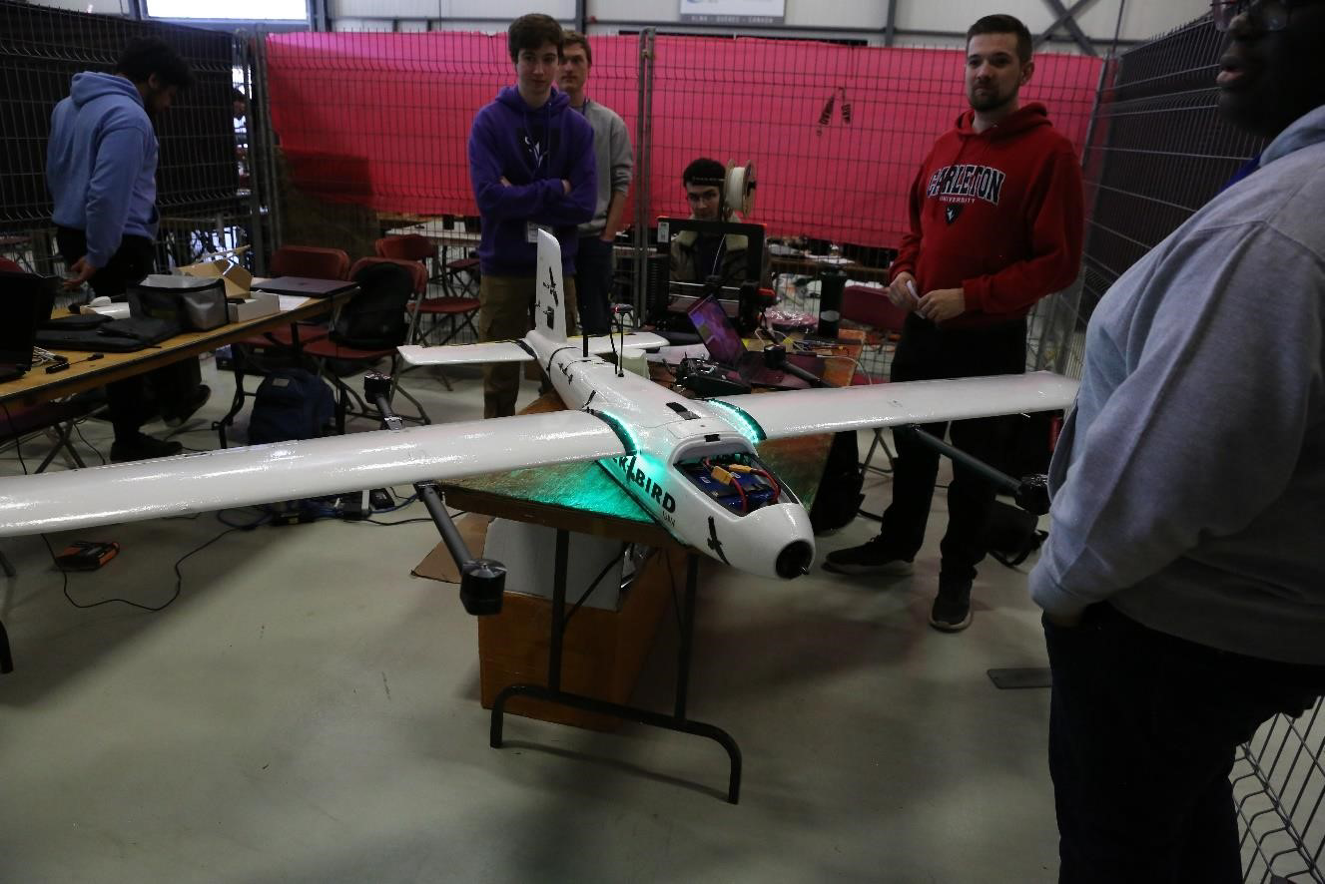
The competition took place in Alma, Quebec from May 5 to May 7, 2023, and the weeks leading up to the competition were quite busy for the team. The first successful flight of the aircraft was made on April 11th, and this marked a major milestone for the team. Hybrid aircraft are quite difficult to operate due to the multiple flight modes and control mixing. The team was able to work through the hardware and software issues during the final exam period at Carleton to prepare for the first flight where a transition from vertical flight to forward flight mode would be achieved. Accomplishing this milestone during the first couple days of May meant the team would be ready to perform the mission at the competition site.
On May 4th, the team packed up their gear from the UAV workshop in Canal Building and proceeded to Alma. This marked the 6th time that Blackbird would be making the roughly 8-hour trek to Alma. At the last competition in 2019, the team was able to place 3rd due to the innovative strategy of using a relay aircraft to extend the effective range of the search and rescue vehicle. After attending the 2022 competition in Southport, Manitoba and acting as observers, the goal the team had in mind for 2023 was to fly a successful mission and place in the top 50% of teams. Once they arrived in Alma, the team from Carleton settled into their workspace and began to tackle the remaining tasks on their to-do list. The team learned lessons from previous years and came prepared with the technical presentation they would be giving the next morning. They also had progressed significantly on the flight-readiness review that was required to allow the team the ability to fly at the competition.
The competition began on the morning of Friday, May 5th with the technical presentations from each team. This year, teams were required to present portions of their presentations in both French and English, which was not an issue for the numerous bilingual members Blackbird brought to the competition. After completing the presentations, the flight-readiness reviews began, but the team started to run into issues. The team was required to demonstrate that the aircraft had a kill switch that would be functional at all times in case the aircraft was to lose communication with the remote pilot and ground station. While the kill switch was functional when the aircraft was in vertical flight, the hybrid configuration of the aircraft posed an issue when in forward flight. The team was given additional time in the afternoon to debug the issue and got some help from another competitor, WARG (Waterloo Aerial Robotics Group) who had a similar aircraft type and had solved the same issue previously. After receiving the all-clear from the judges, the Blackbird UAV Team made their way to the flight line and proceeded to conduct a test flight. While most other teams opted for just hover tests, Blackbird wanted to check the full operation of their systems, so they proceeded to test the transition between hover and forward flight and performed a short flight. It was during this flight that they picked up on a loss of communication in a particular region of the airfield (more on that later). The team piloted the aircraft back to the point of departure and made a successful landing.
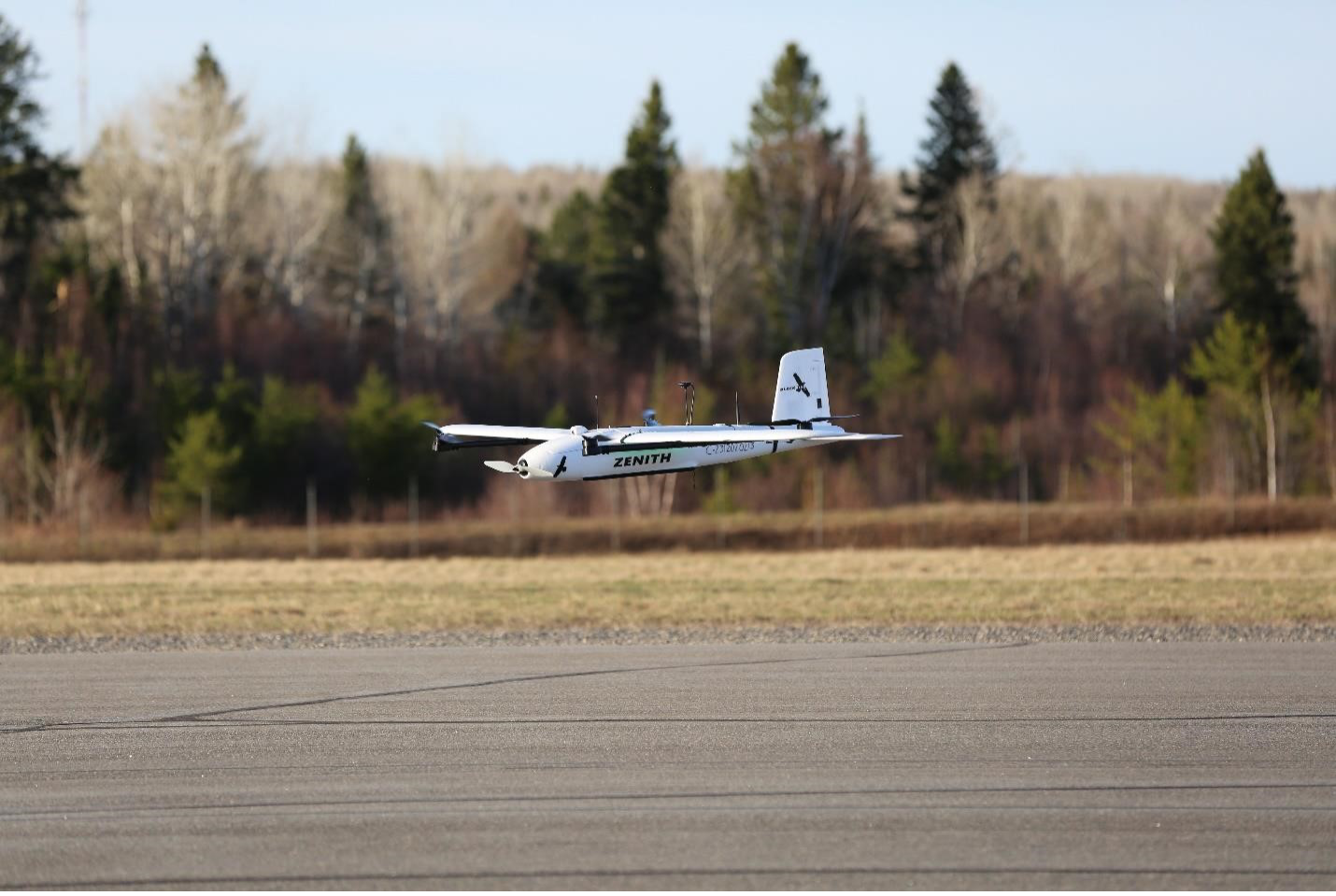
While the test flights on Friday were for practice only, Saturday marked the first scored day of flights. The team had a flight window that was very early in the day, so they showed up to the line to begin their test. After setting up, they recognized an issue with their transmitter which was not responding to the control inputs from the pilot. They tried everything they could during their 1-hour flight window but could not solve the issue. Dejected, the team headed back to the hangar and worked the problem from every angle they could think of. Eventually, they discovered that the transmitter had been reset the previous night during testing and the input scale had been accidentally changed. While this tiny issue was enough to derail the team’s plan to complete the flight on Saturday, the team persevered to resolve the issue and return the following day with a plan to approach the flight mission on Sunday.
While Blackbird was not able to fly on Saturday, many other teams were able to get off the ground and attempt the mission. Most teams would run into difficulty with loss of communication in the same region of the airfield that Blackbird experienced during their Friday flight. However, while Blackbird was able to recover, other teams did not, and in most cases, it led to the loss of their aircraft. Blackbird took note of these results and investigated this problem in more detail. It was the experience of Team Captain, PJ Parisien, who is a specialist in RF communications that recognized the loss of communication issue and hypothesized that there may be some installation causing interference. Performing a search for cell towers in the area, the team identified a brand-new tower built by Bell for 4G communications that was broadcasting at 884 MHz and was likely the source of the interference. The team adapted to this by changing their communications to be over LTE and using the cell tower as a connection link which boosted the range and connection speed of the drone. It was the first time this modification had been successfully implemented at the competition as several other teams indicated they had tried to use LTE for communication but were unable to execute this setup.
The team returned on Sunday to 20-kilometre-per-hour winds that were gusting up to 40 kph. This limited the capabilities of the teams still with aircraft in working order, but Blackbird was least affected due to the hybrid plane-rotorcraft configuration. With the issues limiting the team on the previous day resolved, Blackbird was able to complete two of the passenger routes they were assigned and, in the process, became the only team to successfully complete a route. For this to happen, a lot of work went on in the background. PJ Parisien acted as the pilot, and Jacob Lebrasseur performed the role of air navigator directing PJ where to fly. Dylan Tingley, Ben Pyun, and Imad Rehman handled the aircraft assembly and cabin design tasks to ensure the aircraft was ready for flight. Jed Nevo was responsible for the aircraft tuning. DJ Van Nice took care of the electronics and was ready to step in as the reserve pilot. Meyiwa Jordan Temile was the team’s software leader and wrote numerous algorithms to automate the flight. Felix Chénier acted as the on-site operations manager and filled in where necessary.
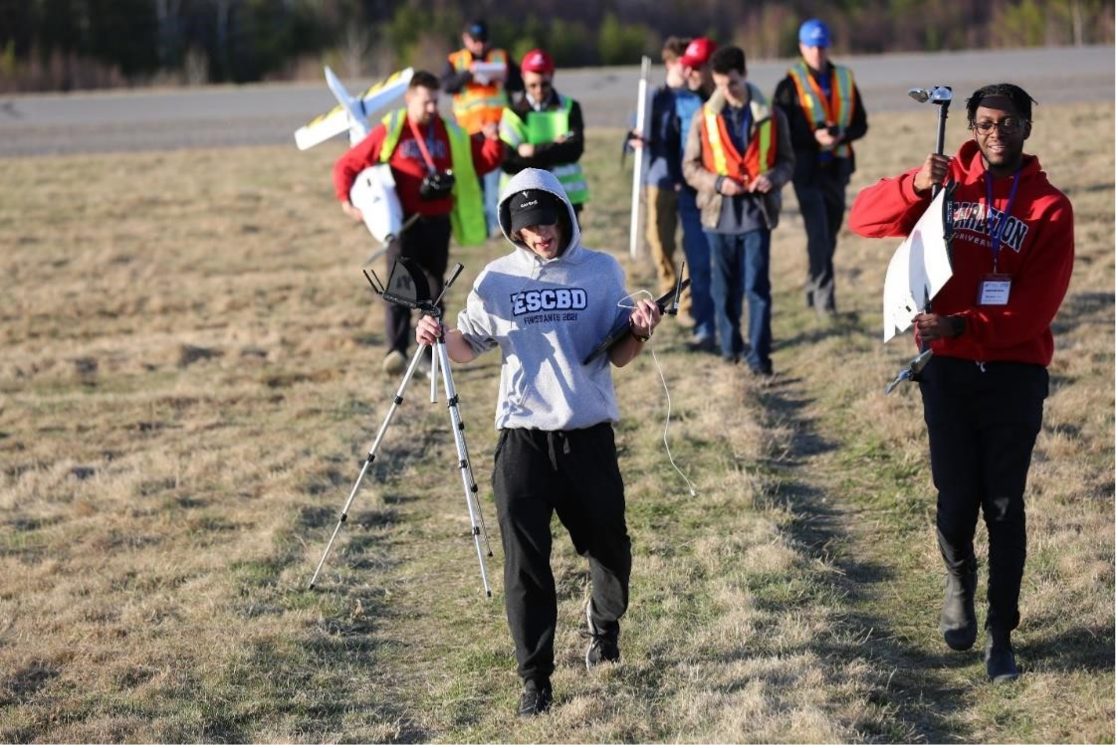
With a successful flight under their belt and as one of the only teams not to crash at the competition, the team was optimistic heading into the awards banquet on Sunday evening. When it came time to announce the winner, Blackbird UAV Team was called, marking the first time that the team had won the flight demonstration phase of the competition. The team was ecstatic knowing that all their hard work had paid off, and they are even more motivated now to perform better at the competition next year.
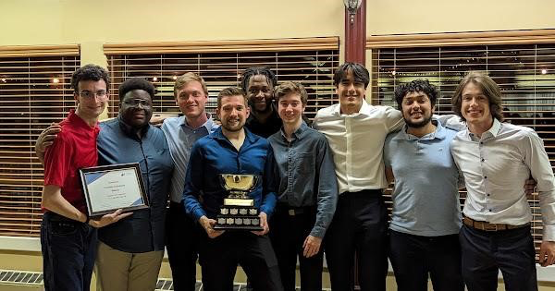
Even though the team was not expecting to win the competition, they focused on achieving their goal of flying and performing parts of the mission. When things went sideways, the team adapted and made do with the circumstances. Their quick thinking, innovative problem solving, and risk management approach led to the outcome that all Blackbird UAV Team members are proud of. The main goal of engineering programs is to develop technical skills in students. Those who participate in extracurricular projects are able to develop skillsets that truly set them apart and help kickstart their careers.
